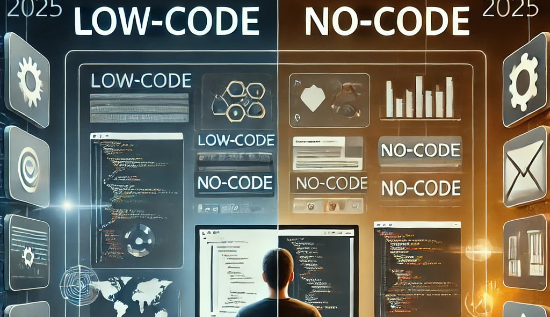Low-Code vs No-Code: Best Platforms & Benefits in 2025

Discover the benefits of low-code vs no-code app builders to streamline development in 2025. Learn the differences and best tools.
Low-code vs no-code systems have changed the field of software development. These technologies let companies create applications quickly without calling for sophisticated programming knowledge. While low-code vs traditional coding offers a middle ground between manual coding and automation with no-code app builders allow complete application creation through drag-and-drop app builders.
This article will explore the benefits of low-code Vs No-Code, the best tools available, and their impact on business automation and digital transformation.
Understanding Low-Code vs No-Code
Low-code vs no-code platforms have become a game-changer in application development. Low-code solutions require minimal coding knowledge, making them ideal for developers looking to accelerate software delivery. No-code app builders, on the other hand, allow users to create applications with no coding at all, making technology accessible to a broader audience.
Their versatility is where low-code vs traditional coding differs most: whereas no-code business process automation depends just on visual programming, low-code coding lets one customize using code when needed.
Read more: Benefits of Low-Code and No-Code Development Platforms
The Benefits of Low-Code Platforms

The benefits of low-code platforms are numerous, particularly for enterprises seeking efficiency in software development.
Key advantages include:
• Faster Development: Compared to low-code vs no-code, applications are built quickly using drag-and-drop app builders.
• Cost-Effective: Businesses save money on hiring large development teams.
• Scalability: Enterprise low-code solutions provide the flexibility needed to scale applications according to business growth.
• User-Friendly Interfaces: Many platforms offer intuitive design features similar to no-code AI solutions.
• Improved results and shorter project times by smooth cooperation between business and IT team.
No-Code App Builders: transforming progress
Modern development patterns start first from no-code app builders. These tools enable firms to create applications without involving developers. The main advantages are in:
• Accessibility for Non-Development: Business analysts can design apps free from technology expertise.
• No-code business process automation improves efficiency by automating tedious chores.
• Many no-code AI solutions today offer intelligent automation in line with artificial intelligence.
• Reduced Cost: Businesses cut their IT budgets by not requiring cost bespoke software.
• Rapid prototyping allows companies to rapidly test and polish application concepts prior to major productions.
Low-Code vs Traditional Coding: Which is Better?
When comparing low-code vs traditional coding, businesses must assess their needs. Low-code platforms provide rapid development while still allowing for customization, making them ideal for large enterprises using enterprise low-code solutions. On the other hand, traditional coding remains essential for highly complex applications requiring deep customization and scalability.
Key differences:
•Development Speed: Low-code vs traditional coding results in faster project delivery.
•Flexibility: Traditional coding offers limitless customization, while low-code solutions provide templates and pre-built components.
•Cost Efficiency: Enterprise low-code solutions save costs by reducing developer dependency.
•Maintenance & Updates: Low-code platforms simplify long-term app maintenance and updates.
Enterprise Low-Code Solutions for Large-Scale Businesses
Large enterprises increasingly rely on enterprise low-code solutions to streamline digital transformation. These platforms provide:
• Scalability: Suitable for growing business needs.
• Integration: Compatible with legacy systems.
• Security: Ensures data protection in enterprise applications.
• Compliance Features: Many solutions include built-in compliance with industry standards.
•AI & Automation: No-code AI solutions enable smarter workflows and predictive analytics.
No-Code Business Process Automation: The Future of Workflow Efficiency
Businesses seeking automation without coding expertise turn to no-code business process automation. This approach enhances operational efficiency by automating tasks such as:
• Customer support chatbots using no-code AI solutions.
• HR onboarding workflows.
• Sales and marketing automation.
• Inventory and supply chain management.
•Data entry and processing tasks.
Top No-Code Platforms for Beginners
For those new to application development, selecting the top no-code platforms for beginners is essential. Some of the best options include:
• Bubble: Ideal for building interactive web applications.
• Adalo: A great choice for mobile app development.
• Out Systems: A leading SaaS low-code platforms for enterprises.
• Zapier: Enables automation without coding knowledge.
•Thinkable: Best suited for building cross-platform mobile applications.
Best Low-Code No-Code Platforms for Startups in 2025
Starting companies gain much from implementing the best low-code no-code platforms for startups in 2025. These systems minimize development expenses and enable rapid product introduction. The important platform consist of:
• Mendix: Offers advanced development feature.
• Appgyver: A robust SaaS low-code platforms for startup.
• Glide: Perfect for effortlessly designing mobile apps.
• Perfect for building and launching online apps is web flow.
• Retool: An inside company tool of choice.
Conclusion
Low-code vs no-code platforms are changing the scene of software development. Although low-code solutions strike a mix between simplicity of use and coding flexibility, no-code apps builders let companies construct applications without technical knowledge.
Whether you're looking for enterprise low-code solution vs no-code business process automation, these platforms offer a streamlined approach to modern development. With the right choice, businesses can innovate faster and remain competitive in 2025.
Frequently Asked Questions
1. Low-code and no-code differ mostly from one another in what way?
While no-code platforms let app creation without any coding and low-code calls for less coding for customizing.
2. Are systems for low-code and no-code fit for businesses?
Indeed, enterprise low-code solution enable big companies to create effectively scalable systems.
3. Are nontechnical people able to use no-code systems?
Indeed, no-code apps builders are meant for non-developer to rapidly construct apps.
4. Are low-code platforms fit for corporate uses?
Enterprise-grade security and compliance tools abound on most SaaS low-code solution.
5. Using no-code for business process automation offers what advantages?
Without involving IT assistance, no-code business process automation helps to simplify repetitive operations.
6. For startups in 2025, which low-code no-code systems are most suited?
Mendix, Out Systems and Glide are the best low-code no-code systems available to startups looking forward 2025.
7. In terms of adaptability, how does traditional and low-code coding stand?
While traditional coding lets total customizing, low-code coding provides speedier development with some coding flexibility.
More Articles
 10 Dec 2025
10 Dec 2025
Latest Freelancing Trends in Technology for Remote Work
Stay ahead in remote work with insights on Freelancing trends in technology, top skills and global technology freelance opportunities.
 10 Dec 2025
10 Dec 2025
Cloud Disaster Recovery Planning for Business Continuity
Cloud Disaster Recovery Planning helps businesses stay resilient with clear strategies that reduce downtime and protect critical operations.
 09 Dec 2025
09 Dec 2025
Tech Startup Funding Trends and Strategies 2026
Stay ahead of 2026 tech startup funding trends with insights on winning strategies, investor expectations, and capital-raising tactics for early-stage founders.
 09 Dec 2025
09 Dec 2025
Link Building Strategies for Higher Rankings – Updated
Boost your SEO with actionable link building strategies that strengthen rankings and support long-term growth.